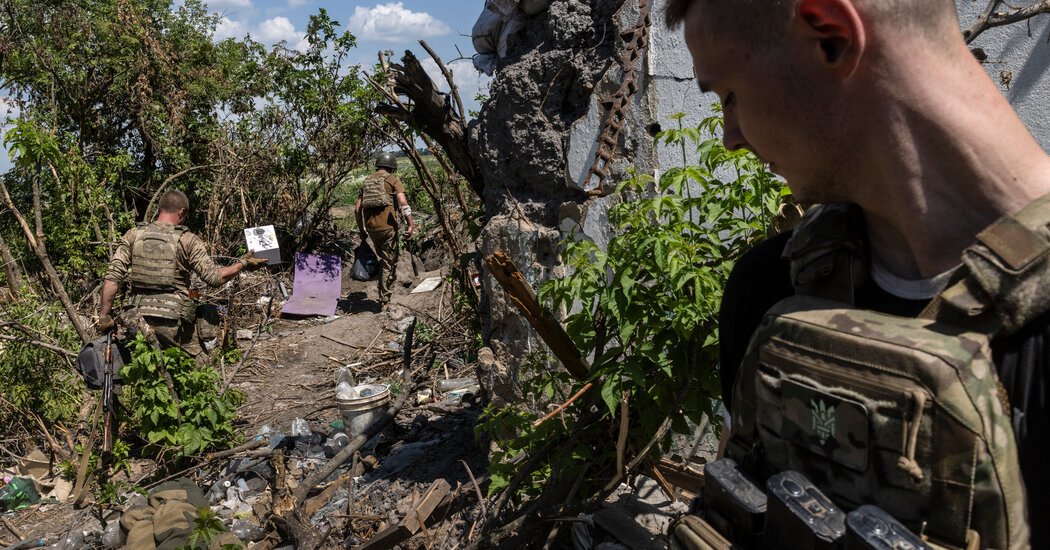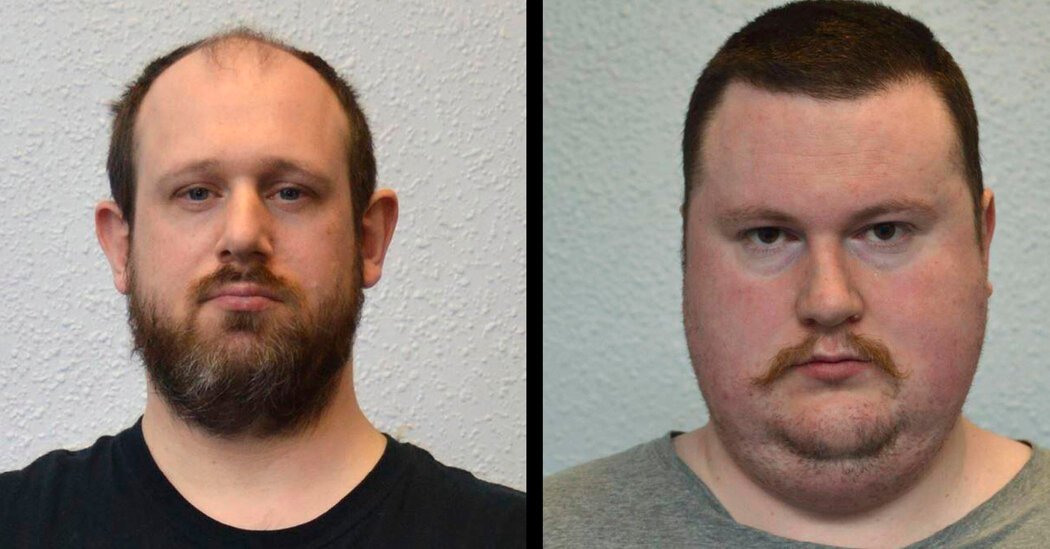Displaced residents in Myanmar had just returned to their village to get more rice when a military jet flew overhead, a survivor said. Video captures the airstrike, which killed four people.
No target appears to be off limits for the military, which has made attacking civilian structures central to its war against opposition groups.
The New York Times verified videos and photographs, analyzed data and satellite imagery and interviewed residents. The evidence shows that brutality against civilians is escalating.
Internet shutdowns and digital surveillance prevent much information from trickling beyond Myanmar’s borders. But behind the veil of secrecy, the military is carrying out a devastating and indiscriminate campaign of violence.
Even for a country long notorious for military abuses, the violence and humanitarian crisis now are unprecedented, many experts say.
Myanmar has experienced nearly continuous conflict since its independence in 1948. The country’s military holds unusual power, ruling for decades and often using force to squelch opposition. Its ethnic-cleansing campaign against Rohingya Muslims in 2017 set off one of the largest refugee crises in history, prompting an international outcry.
Then in 2021, the military staged a coup after an election, and protesters soon filled the streets. When demonstrators were met with a violent crackdown, the opposition’s National Unity Government, led by ousted politicians and activists, established an armed resistance force.
The opposition and its allied forces now effectively control large swaths of the country. As they have gained ground, the military has resorted to increasing air attacks — many of which hit civilians.
Data shows that there were nearly twice as many military airstrikes reported in April, May and June as in the first three months of the year. Visuals analyzed by The Times and witness accounts reveal what that escalation looks like on the ground — and how attacks against civilians play an essential role in the military’s strategy.
The military’s strategy is to punish the civilian population for any perceived support of the opposition, said Anthony Davis, an analyst for the Janes group of military publications and an expert on the Myanmar military.
“It’s about burning villages, bombing villages and forcing the civilian population out of villages,” Mr. Davis said.
Some of those tactics were once used against the Rohingya population in Rakhine State. Back then, the junta displaced around one million people. Since the February 2021 coup, 1.5 million people have been displaced, according to a report released by the United Nations High Commissioner for Human Rights on June 28. Local organizations have estimated the number to be significantly higher.
The United Nations High Commissioner also reported that at least 3,452 people had been killed by the military and its allies since the coup.
“Until the military dictatorship is overthrown, we remain haunted by the uncertainty of which day our lives may be extinguished,” said U Maung Maung, 25, who was injured while fleeing an airstrike in February.
“Almost every day, our village endured bombings”
Opposition forces are now effectively in control of half Myanmar’s land. With the fighting no longer limited to pockets of the country, the military is woefully undermanned on the ground, said Mr. Davis, the Janes analyst. “It’s not just, We’re fighting in Rakhine or we’re fighting in Kachin. What you’ve got now is the military on the back foot increasingly having to fight almost everywhere.”
The military is using jets supplied by China and Russia and relies on a fuel supply chain that experts say should be hit with stronger sanctions to rein in the attacks. “As long as the Myanmar military continues to be allowed to get access to aviation fuel, we are only going to see more and more civilian suffering,” said Nang Sein, the Myanmar researcher at Amnesty International.
While opposition groups have expanded their arsenal of light weaponry, their only airpower is small drones rigged to drop homemade munitions. These drones have been increasingly used to target military posts and troops.
Resistance forces, too, have been accused of abuses during the conflict. But the indiscriminate nature of the air campaign, and its widespread impact on civilians, is unique to the military.
In some of its most brazen attacks, the military has launched airstrikes on public events seen as affiliated with the opposition — including the opening of an administrative center in the Sagaing region and a concert for the anniversary of an independence group in Kachin State.
Source: The Armed Conflict Location & Event Data Project (ACLED)
Note: Data as of June 30.
Data from the Armed Conflict Location & Event Data Project, which collects information on conflicts around the world, shows that airstrikes have become more frequent throughout the conflict. Over 40 military strikes were reported in June alone — more than any other month this year. Altogether, 2023 has had a monthly average of 30 airstrikes, the highest for any year of the conflict so far.
Most of the airstrikes take place in opposition-held areas.
In some cases, these strikes are called in by ground forces to counter specific opposition attacks on army posts. But much more often, they are indiscriminate, which means that civilians bear the brunt of the violence. Mr. Davis estimated that at least 85 percent of deaths from the strikes were civilian.
“Right now, air power is very largely about punishment,” he said. “Its direct military impact is pretty minimal.”
The strikes come at all hours of the day, some as early as 4 a.m.
“The military wants to send a message that you either stay on our side or you are our enemy,” said Ms. Nang, the Amnesty International researcher.
The military has been carrying out airstrikes more frequently
Source: The Armed Conflict Location & Event Data Project (ACLED)
Note: Data as of June 30.
Visual evidence verified by The Times shows that strikes have hit schools, hospitals and places of worship. In several cases, local residents said that there had been no resistance fighters present in their village, though there was no way to confirm this.
On June 27, a military jet struck a monastery in the village of Nyaung Kone. One resident, U Zaw Htwe, said that a monk and nine other civilians had been killed. Images from the scene show the monastery destroyed.
Other photographs show damage to a high school and to a hospital in the Sagaing region after an airstrike on Feb. 23. “The primary focus of the assault that day was the hospital,” said Mr. Maung Maung, the resident who was injured.
Source: Ayadaw Post via Facebook
And nine people, including four children, were killed in what witnesses said was a military airstrike on March 30 in the village of Khuafo, in Thantlang Township. Video shows extensive destruction in the village.
Ngun Hoi, 40, was seriously injured in the airstrike. She remains bedridden in a hospital after having a steel rod inserted in her leg. Mrs. Ngun Hoi has fled attacks by the military multiple times since the coup, a common experience in Myanmar.
“I served as an employee at a hospital in Thantlang,” she said. “Unfortunately, the Myanmar military burned our home there, compelling me to seek refuge in Khuafo village — where fate had an airstrike in store for me.”
Nine people, including children, were killed in what witnesses described as an airstrike in Thantlang Township.
Salai Tial Hram Ling
“They perished in the flames”
The burning of villages, like Mrs. Ngun Hoi’s former home, is another tactic long used by the military to break the will of the opposition. As with the air campaign, the military has recently escalated its scorched-earth campaign.
Drone footage captures the military in the act of burning down Let Htoke Taw village in the southern Sagaing region.
An armed man walks out of one of the homes. Moments later, it goes up in flames.
A satellite image captured on May 6 confirms the date of the attack. Fires raging in several parts of the village are visible.
When fighter jets or helicopters are involved, attacks can be easily attributed to government forces. But responsibility for fires is often much more difficult to prove. The video of the soldier leaving the house, first analyzed and shared with The Times by the nongovernmental organization Myanmar Witness, is rare evidence of troops in the act.
Mr. Davis, who reviewed the footage, said there was no doubt that this was state security forces at work. “The helmets, the distinctive way many of them shoulder their rifles and the military discipline and organization at some moments make that entirely clear,” he said.
Daw Thein Htay, whose home was burned in the attack, said that soldiers had threatened to incinerate the village unless residents disclosed the location of an opposition leader. “When we said we did not know, they set our village on fire,” she said.
Fires like this are most concentrated in the opposition stronghold of Sagaing; some villages have been burned repeatedly. Mrs. Thein Htay said that the villagers in Let Htoke Taw were warned of a repeat attack if they dared to reconstruct their homes.
A recent analysis by Myanmar Witness found an alarming increase in fires, with nearly six times as many identified in December 2022 as in December 2021. The United Nations High Commissioner for Human Rights said in July that around 60,000 civilian structures had been burned since the start of the coup.
Satellite imagery reveals the extent of the destruction wrought by fires in Myanmar. Between May 25 and June 1 alone, The Times identified at least seven clearly burned villages spread across three states.
Four were captured in satellite imagery while burning.
The destruction of food storage facilities and livestock has also been a common tactic in the military’s offensive. Photographs shared by Myanmar Witness show the burning of grain piles and of a rice storage facility in mid-November in Paung Hle Kone in the Sagaing region.
Source: Khin-U Township News via Facebook
One resident, U Maung Tun Sein, said that Paung Hle Kone was just one of several villages in the area where the military had destroyed rice storage facilities that week.
Civilians across the country have died in the raids and widespread burning.
“Even as we sought refuge in the jungle while our homes were torched, we remained in hiding because the soldiers of the army pursued us,” Mr. Maung Tun Sein said. “Their objective was not solely to destroy houses but to inflict harm upon the inhabitants as well.”
Some vulnerable groups, like the elderly, are not able to flee at all. On March 25 in Sagaing’s Son Kone village, over 150 homes were burned to the ground. Six of the seven people killed in the fire were 70 or older, a resident said.
“When the soldiers arrived at the village, seven elderly individuals who were unable to flee sought refuge in their homes,” recounted U Sein Myint, a survivor of the attack. “Tragically, the military set their houses ablaze, leaving them with no means of escape. The elderly residents met a horrifying fate as they perished in the flames.”
Nearly everyone who spoke to The Times said they lived in constant fear. Even outside the most active conflict zones, the military carries out extensive monitoring to suppress support for the opposition. Any hint of resistance can lead to arrest.
“In Myanmar, people die every day because the army kills them, but we don’t even dare to change our profile picture on Facebook to a black screen as a sign of mourning,” said U Thet Swe, a businessman in Yangon. “We are living in such a situation that we do not dare to mourn the death of our own citizens.”
Nearly 200 homes were burned to the ground in Son Kone village in the Sagaing region.
Citizen journalist





